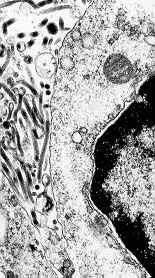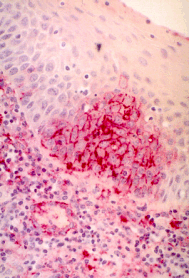
| MadSci Network: Virology |
Kim,
Ebola virus is an RNA virus that is the cause of Ebola Hemorrhagic Fever. Viruses that belong to this relatively new category are long and thin when examined by electron microscopy (figure 1). They are called filoviruses because of this resemblance to filaments. Filovirus have been found in Africa and the Philippines and in monkeys imported from these sites. Several strains of Filoviruses have been named because of the places where outbreaks have occurred, i.e. Ebola Zaire, Ebola Reston and Marburg virus. Ebola Reston does not cause serious disease in man but is lethal to monkeys. Ebola Zaire and Marburg virus cause serious disease in both monkeys and man.

Ebola virus is spread through close personal contact with a person who is very ill with the disease. In previous outbreaks, person-to-person spread frequently occurred among hospital care workers or family members who were caring for an ill person infected with Ebola virus. Transmission of the virus has also occurred as a result of hypodermic needles being reused in the treatment of patients. Medical facilities in the United States use disposable supplies and do not reuse needles.
During outbreaks of ebola virus in Africa it was noticed that grieving family members would touch and kiss the deceased as part of the mourning practices. Because the virus is often in secretions and close to the surface of the skin (see the red stained ebola antigens in the section of monkey lip in figure 2) such close contact could be responsible for the rapid spread of disease among family members and health care workers who must touch the patient while providing care. Use of barriers like gowns, rubber gloves and face masks were effective in preventing spread.

Once the virus has gained access to the body it rapidly spreads to the bloodstream. This occurs because the virus infects many cell types but seems to prefer to infect a connective tissue cell that is found supporting epithelial cells of the skin and mucus membranes but also supports blood vessel walls. Recent research has shown that this connective tissue cell, called the fibroblastic reticular cell, is capable of conducting materials from tissue to the blood and it is possible that the virus sneaks in to become a passenger.
Replication of the virus in these fibroblasts causes them to break down and this weakens the walls of small blood vessels. This results in oozing of blood in all the parts of the body that are normally moist like the eyes, nose, mouth, gastrointestinal and urogenital systems. Capillaries under the skin may also break resulting in bruises and small red spots.
The infected patient may not show these signs right away. Symptoms of Ebola hemorrhagic fever begin 4 to 16 days after infection. Then the patient will develop fever, chills, headaches, muscle aches, and loss of appetite. As the disease progresses, vomiting, diarrhea, abdominal pain, sore throat, and chest pain can occur. The blood fails to clot and patients may bleed from injection sites as well as into the gastrointestinal tract, skin, and internal organs. This failure of the blood to clot is a result of depletion of the proteins in the blood that control clotting. When this occurs at the same time as blood vessels are weakened by virus, blood loss can be considerable.
These signs and symptoms are frightening whenever there is an outbreak of this disease. Fortunately these outbreaks are very rare and frequently do not spread beyond the villages where they occur. However, this serious disease is one of the best known of the hazardous diseases because of books like "The Hot Zone" by Richard Preston, news reports on TV and movies like "Outbreak" starring Dustin Hoffman.
Here are a series of links to sites that will enable you to learn more about Filoviruses and Ebola virus.
Try the links in the MadSci Library for more information on Virology.